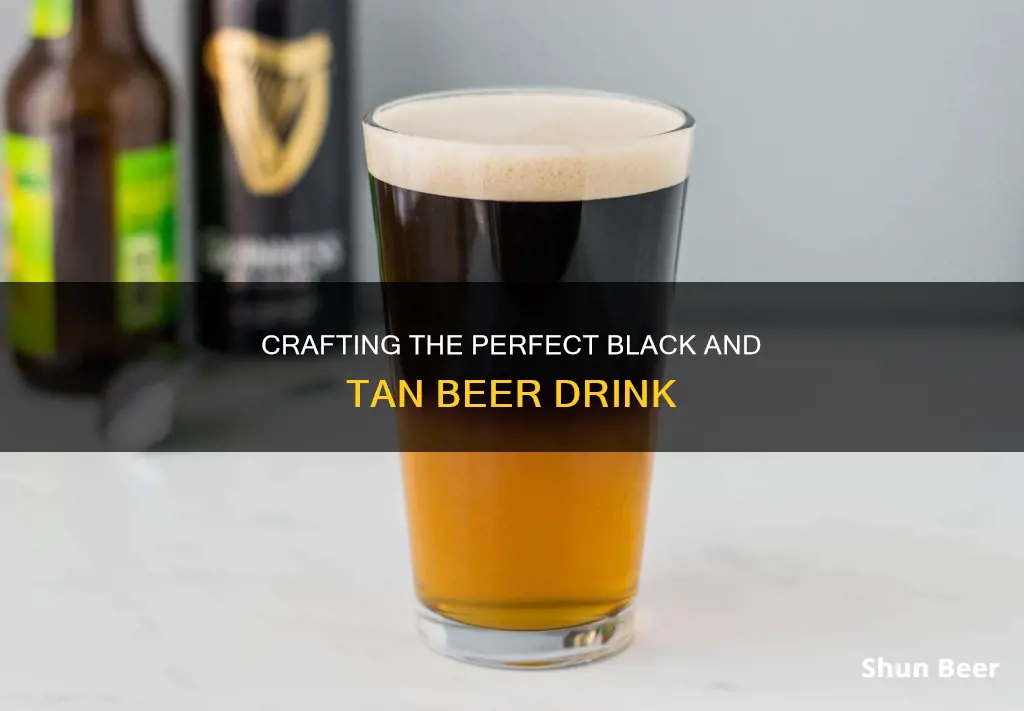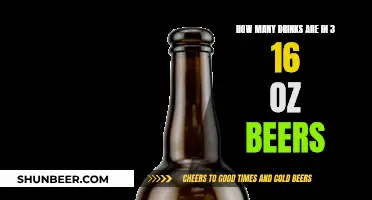
The black and tan is a visually striking drink, with a deep, dark stout floating atop a lighter ale. It's a simple combination of two beers, a fifty-fifty mix of stout and ale, but it requires a bit of technique to get the layering just right. The drink is made with a pale ale, such as Bass, and a stout, such as Guinness, which has a lighter density than the ale, allowing it to float on top. The key to achieving this effect is to pour the stout slowly over the back of a spoon, so that it dribbles into the glass and stays separated from the ale. While the black and tan is a popular drink in bars across the US, it has controversial connotations in Ireland, where it is associated with a British paramilitary force that suppressed the Irish independence movement in the early 1920s. As a result, it's considered offensive to order a black and tan in Ireland, and it's recommended to ask for a half and half instead.
| Characteristics | Values |
|---|---|
| Type of drink | Beer cocktail |
| Number of beers | 2 |
| Beer types | Pale ale and stout |
| Beer brands | Bass Ale and Guinness |
| ABV | 4.7% |
| Glass type | Tulip pint glass or Irish imperial pint glass |
| Pouring technique | Slow pour over the back of a spoon |
| Number of layers | 2 |
| Layer colours | Black and tan |
What You'll Learn

Choosing the right glassware
The ideal glass for a Black and Tan is a tulip pint glass or an Irish imperial pint glass. The shape of these glasses perfectly showcases the distinct layers of the drink, with the tulip pint glass tapering down to a narrower bottom and the Irish imperial pint glass featuring a slight taper with a slightly wider bottom. Both options effectively maintain the flavour profile of the beer.
If you don't have access to a tulip pint glass or an Irish imperial pint glass, other suitable alternatives include a shaker pint, English tulip pint, or nonic pint glass. The key is to choose a glass with a wide enough opening to accommodate the slow pour technique, ensuring a clean separation between the ale and stout layers.
The nonic pint glass, commonly found in British pubs, is easily recognisable by its distinctive bulge about two inches from the top. The American pint glass, also known as a shaker glass, is slightly wider at the mouth than at the base and typically holds 16 ounces. The Imperial glass, with a capacity of 20 ounces, is similar in shape to the American pint glass and works just as well for crafting a visually appealing Black and Tan.
Remember, the success of your Black and Tan depends on the layering effect, so make sure to practice the slow pour technique and choose a glass that facilitates this process.
Beer Drinking in Abu Dhabi: What's the Deal?
You may want to see also

Mastering the slow pour technique
Firstly, choose the right glassware. A tulip pint glass or an Irish imperial pint glass is recommended as their shape showcases the stunning layers and maintains the flavour profile. However, other glasses such as a shaker pint, English tulip pint, or nonic pint can also be used as long as they have a wide enough opening to accommodate the slow pour technique.
Now, for the pouring technique itself. Begin by filling your chosen glass a little more than halfway with a pale ale. The exact amount will depend on the size of your glass, but as a general rule, you want to fill it just over halfway. This will give the beer a nice head.
Next, you'll need a spoon. A specialised layering tool or "black and tan spoon" can be used, but a regular teaspoon will also work. Hold the spoon over the top of the glass and turn it over so the side you would normally eat from is facing up (convex). Alternatively, some sources suggest flattening the bowl of the spoon with a hammer to create a flat surface.
Now, slowly pour the stout over the back of the spoon. This will gently disperse the stout so that it settles on top of the ale without the two mixing together. Pour the stout slowly and evenly, allowing it to dribble into the glass. You may need to slowly raise the spoon as the liquid level rises. The key is to pour slowly and with control so that the two beers remain separate, preserving the striking layers.
With a little practice and patience, you'll be pouring perfect Black and Tans in no time!
Beer and Zoloft: Is It Safe to Drink Alcohol?
You may want to see also

The history of the Black and Tan
The tradition of blending beers was initially a way for bar owners to reduce their tax burden, as different beers were taxed at different rates. By mixing a lower-taxed beer with a higher-taxed one, bar owners could lower the overall tax rate of the drink. This practice continued from the late 1690s to the 1700s.
The name "Black and Tan" is derived from the colours of the two beers used: a Bass pale ale at the bottom and Guinness stout beer on top. These two beers create perfect "black and tan" layers in the glass when poured correctly. The Irish-Americans prefer their Black and Tans to be made with Guinness floated on top of Bass Ale, visually mimicking the Black and Tan soldiers.
However, it is important to note that ordering a "Black and Tan" in Ireland is considered offensive due to its association with the British paramilitary force nicknamed the "Black and Tans", which was involved in suppressing the Irish independence movement in the early 1920s. This force was known for its violent tactics, including the burning of towns and civilian slaughter. As a result, the drink is referred to as a Half and Half in Ireland.
Beer and Leaky Gut: What's the Connection?
You may want to see also

The cultural significance and controversy of its name
The name "Black and Tan" carries a weighty history and cultural significance, especially in Ireland. While the drink is a beloved layered cocktail in many parts of the world, the term has controversial connotations in Ireland due to its association with a violent period in the country's history.
The term "Black and Tan" is linked to the British paramilitary force, known as the Royal Irish Constabulary Reserve Force, that was sent to Ireland in the early 1920s during the Irish War of Independence. This force became infamously known as the "Black and Tans" because of their distinctive uniforms, which consisted of khaki pants and dark green shirts. The presence of these forces in Ireland resulted in violent clashes with the Irish people, as they sought to suppress the Irish independence movement. As a result, ordering a "Black and Tan" drink in Ireland is considered offensive and inappropriate. The name evokes memories of a tragic and brutal time in the country's struggle for independence.
The violent tactics employed by the "Black and Tans" left a lasting impact on Ireland's history and collective memory. Their actions during this period were marked by brutality and suppression of the Irish independence movement. This force was known for its aggressive methods, which included raids, assaults, and even killings of Irish civilians. Their actions had a profound and detrimental effect on community relations and exacerbated tensions during this tumultuous time in Ireland's fight for freedom from British rule.
Due to these historical associations, the term "Black and Tan" is sensitive and carries a negative connotation in Ireland. As a result, it is recommended to use alternative names for the drink when in Ireland, such as "Half and Half." This alternative name is widely used and helps to avoid causing any unintended offense to locals. It is important for visitors to be mindful of this cultural sensitivity and adapt their language accordingly when ordering or referring to this drink in Ireland.
The controversy surrounding the name "Black and Tan" has also extended beyond Ireland. There have been instances where companies have released products with this name, unintentionally causing offense. For example, in 2006, Ben and Jerry's released a "Black and Tan" ice cream flavor for Saint Patrick's Day in the United States, which offended Irish nationalists due to its paramilitary association. Similarly, in 2012, Nike faced criticism for advertising a pair of shoes as the "Black and Tan" as part of an Irish-themed design collection. These incidents highlight the need for cultural awareness and sensitivity when using terms that may have historical or controversial connotations.
Beer and Sore Throats: A Risky Relief?
You may want to see also

Variations and twists on the classic recipe
There are several ways to mix up the classic black and tan recipe while still enjoying the unique layered look and the interplay of dark and light beers. One simple variation is to substitute a different style of beer for one of the layers. For example, try using a stout with a higher ABV (alcohol by volume) or a foreign extra stout, which will add more robust flavors of coffee and chocolate. Alternatively, go for a milk stout, which will bring a sweet, creamy edge to the drink. When choosing the lighter beer, consider a pale ale or even an IPA, which will contribute more bitterness and hoppy flavors to the mix.
You can also experiment with different ratios of the two beers. The traditional black and tan uses a 50/50 split, but you could try pouring a smaller amount of the dark beer, so it makes up only a third of the total drink, allowing the lighter beer to dominate. Or, if you prefer your drinks on the stronger side, reverse the ratio and go for a two-thirds stout, one-third lager pour, ensuring the dark beer takes center stage. Another option is to add a twist of flavor with a complementary spirit. A measure of whiskey, particularly an Irish whiskey, can enhance the drink's warmth and spice, while a dark rum will bring a rich, sweet edge.
For a fruity variation, try adding a splash of fruit beer or cider to the mix. A raspberry or cherry lambic will contribute a tart, fruity note, while a crisp, sweet cider can add a refreshing twist. If you're feeling creative, you could even make your own flavored beer by infusing a simple syrup with fruits or herbs. Try infusing syrup with blackberries or rosemary, for example, to add a unique, complementary flavor to the drink. Finally, don't be afraid to get creative with your glassware and garnishes. A black and tan can be served in a variety of glasses, from a traditional pint glass to a more elegant cocktail glass or goblet.
Garnishes could include a twist of lemon or orange peel, a sprig of fresh herbs, or even a dusting of cocoa powder or cinnamon, depending on the flavors you want to emphasize. Remember, the key to a successful black and tan variation is to maintain the contrast between dark and light, both in color and flavor, while adding your own unique twist. Whether you're experimenting with different beer styles, ratios, or added ingredients, there are plenty of ways to make this classic drink your own. So get creative, and don't be afraid to try something new!
Beer and Liquor: Mixing Alcohol Safely?
You may want to see also
Frequently asked questions
A Black and Tan is a drink made by layering a light-coloured ale with a dark stout.
A Bass pale ale is used for the bottom layer, and a Guinness stout is used for the top layer.
First, pour the ale into a pint glass, filling it about halfway and creating a head on top. Then, slowly pour the stout over the back of a spoon, allowing it to settle on top of the ale to create a layered effect.
The key to achieving the perfect layering effect is to ensure that the two beers have different densities, with the stout being less dense than the ale so that it floats on top.
A tulip pint glass or an Irish imperial pint glass is recommended for a Black and Tan, as their shape showcases the layers and maintains the flavour profile.







